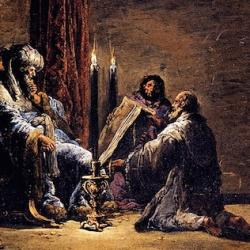The genealogy of Levi is at the center of the genealogical section of 1 Chronicles. The genealogy begins with Adam and reaches ahead to the restoration from exile. In short, the genealogies survey all of human history, and, with the Levites at the center, it’s as if the human race exists specifically to produce a priestly tribe, a tribe of singers and sacrificers and temple guardians.
The section of the Levi genealogy in 1 Chronicles 6:16-30 is straightforward in general, tangled and difficult in details. The overall pattern is clear. The three sons of Levi are named – Gershom, Kohath, and Merari (v. 16). The sons of each are listed, in a numerically symmetrical pattern: 2 sons of Gershom, 5 of Kohath, 2 or Merari (vv. 17-19), and a summary statement announces that “these are the families of the Levites according to their fathers” (19b).
From there, the genealogy provides an inter-generational list, again organized in the triad of three sons and again the same order. The general structure of verses 20-30 is also clear, and again is numerically symmetrical:
A. Seven generations of Gershom, vv. 20-21.
B. Generations of Kohath, vv. 22-28.
A’. Seven generations of Merari, vv. 29-30.
If we include Gershom and Merari in their genealogies, then we have lists that stretch to eight generations. Overall, we have three genealogical cycles, each expanding on the former, each organized around the three sons of Levi. First the sons themselves; then their sons; then their descendants to seven or more generations.
The tangle comes at the center of the genealogy, in the list of generations from Kohath, the longest and most complex of the lists. It begins with a straightforward list of ten generations from Kohath (11 if inclusive). Verse 25 focuses on the fourth generation from Kohath, Elkanah, and names two sons (Amasia and Ahimoth), neither of which is a son of Elkanah in verse 23. Then verse 26 begins yet another list of Elkanah’s descendants, listing five generations of descendants that ends with another Elkanah (v. 27). Between verse 23 and verse 27, the name “Elkanah” appears five times. (The name appears three more times in verses 34-36, which gives a different genealogy from Kohath.)
Verse 29 suddenly introduces Samuel, unmentioned to this point. His sons are Joel and Abijah, who are listed as the sons of the prophet Samuel in 1 Samuel 8:2. So this Samuel is the Samuel, and one of the Elkanah’s is his father (cf. 1 Samuel 1). That is one reason for focusing on Elkanah, and the other is the centrality of this clan of Levites in the formation of the Levitical choir whose genealogy occupies verses 31-48.
The tangle of Elkanah’s genealogy may be resolved as follows:
A. Two sons of Elkanah, v. 25
B. Five generations of Elkanah, vv. 26-27.
A’. Two sons of Samuel, v. 28.
That numerically matches the lists of sons of the sons of Levi at the beginning of the section (2-5-2), and may suggest that the clan of Elkanah is a clan of “Levites within Levi,” even a clan of super-Levites. Each of the sons of Levi is mentioned three times in this section of genealogy, but the name Elkanah is mentioned five times (not always the same man). The Hebrew elqanah means “God possesses” or “God buys” or “God makes.” Elkanah is a perfect name for a Levite, the tribe purchased by God by Exodus and the tribe that is God’s special possession among the special possession that is Israel.















